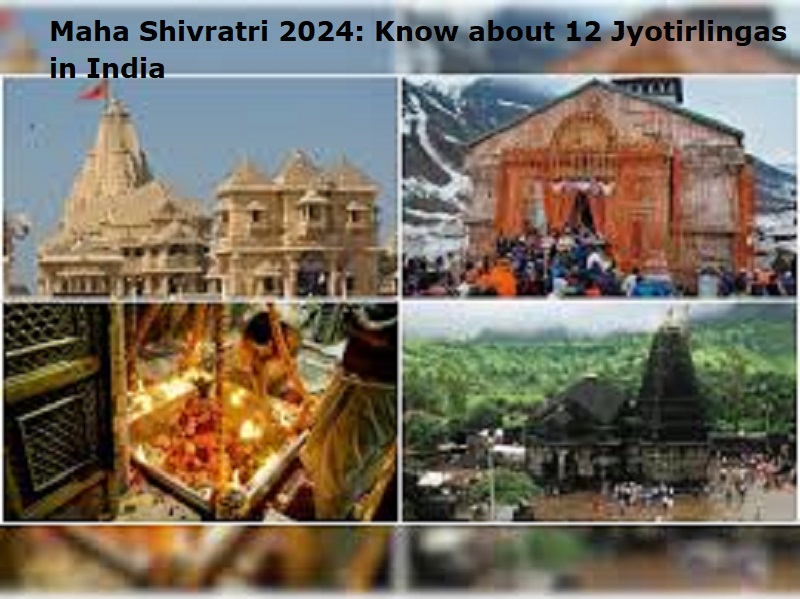
Mumbai: Maha Shivratri also known as ‘the Great Night of Shiva’ is a Hindu festival. It is a special day dedicated to worshipping Lord Shiva. This year, the festival will fall on March 8, 2024.
A Jyotirlinga is a shrine where Lord Shiva is worshipped in the form of a fiery column of light. ‘Jyoti’ means ‘radiance’ and Lingam, the Shiva Lingam-‘the mark or sign’ of the Almighty or the phallus symbol. Hence, Jyotirlingam means the the radiant sign of the Almighty.
There are 12 Jyotirlinga shrines in India. The 12 Jyotirlingas are Somnath in Gujarat, Mallikarjuna at Srisailam in Andhra Pradesh, Mahakaleswar at Ujjain in Madhya Pradesh, Omkareshwar in Madhya Pradesh, Kedarnath in Uttrakhand, Bhimashankar at Pune in Maharashtra, Viswanath at Varanasi in Uttar Pradesh, Tryambakeshwar at Nashik in Maharashtra, Vaijyanath Temple in Deoghar District of Jharkhand, Aundha Nagnath at Aundha in Hingoli District in Maharashtra, Rameshwar at Rameshwaram in Tamil Nadu and Grushneshwar at Ellora near Aurangabad, in Maharashtra.
Somnath Temple: Located in Gujarat, Somnath Temple is believed to be the first among the 12 Jyotirlingas. It is situated on the coast of the Arabian Sea and is one of the oldest and most revered temples in India. According to legend the temple was created by the Moon God himself.
Also Read: Know how to do ‘Kapalbhati Pranayama’ and its benefits
Mallikarjuna Temple: This temple is situated in Srisailam, Andhra Pradesh and is dedicated to Lord Shiva and Goddess Parvati. Mallikarjuna Jyotirlinga is one of the 275 Paadal Petra Sthalams that are amongst the greatest Lord Shiva temples in Asia.
Mahakaleshwar Temple: Located in Ujjain, Madhya Pradesh, this temple is known for its unique lingam, which is believed to be self-manifested. The idol of Mahakaleshwar is known to be dakshinamurti, which means that it is facing the south.
Omkareshwar Temple: This temple is situated on an island in the Narmada River in Madhya Pradesh. It is believed that the island is in the shape of the Hindu symbol ‘Om’, hence the name Omkareshwar.
Kedarnath Temple: Located in Uttarakhand, Kedarnath Temple is situated at an altitude of 11,755 feet. It is one of the 275 Paadal Petra Sthalams and was built by the Pandavas and revived by Adi Sankaracharya.
Bhimashankar Temple: This temple is situated in Pune, Maharashtra and is believed to be the place where Lord Shiva defeated the demon Tripurasura. It is also the source of River Bhima in the Bhimashankar hills in Khed Taluka. Built in the Nagara style of architecture, this temple dates back to the 18th century.
Kashi Vishwanath Temple: Located in Varanasi, Uttar Pradesh, Kashi Vishwanath Temple is considered to be one of the most sacred temples for Hindus.
Trimbakeshwar Temple: Situated in Nashik, Maharashtra, this temple is believed to be the place where the river Godavari originated from the Brahmagiri mountain. According to Shiva Purana, on request of the Godavari and Gautam Rishi, Lord Shiva decided to reside as Trimbakeshwar. It is considered to be a unique jyotirlinga: the linga has three faces symbolizing Lord Brahma, Lord Vishnu and Lord Shiva. The Jyotirlinga is covered by a jewelled crown, which is placed over the golden mask of the three gods.
Vaidyanath Temple: This temple is located in Deoghar, Jharkhand and is considered to be one of the most powerful Jyotirlingas. It is believed that a visit to this temple can cure all kinds of diseases. The jyotirlinga got its name Vaidhya literally meaning ‘doctor’ from the fact that Lord Shiva cured demon king, Ravana as he was the greatest Shiva worshipper.
Nageshwar Temple: Situated in Dwarka, Gujarat, this temple is dedicated to Lord Shiva in the form of Nageshwar. It is believed that a visit to this temple can relieve one from all kinds of poisons.
Rameshwaram Temple: This temple situated at the Rameswaram Island in Tamil Nadu.. According to Hindu mythology, the jyotirlingam was made by Lord Rama himself to make amends of killing Ravana, a Brahmin in the battlefield. He asked Hanuman to bring a lingam from Kailash, but as it was getting late, he worshipped the lingam made of sand by Devi Sita. It is believed that alike lingam is placed inside the sanctum. This Lingam worshipped by Lord Rama is known as Ramanathar.
Grishneshwar Temple: This temple is situated in Aurangabad, Maharashtra and is believed to be the last among the 12 Jyotirlingas. It is also known as the Kusumeswarar temple and a visit here is considered to be highly auspicious. Ghrneshwar means the ‘lord of compassion’. The Grishneshwar Jyotirlinga temple is built of red rock and composed of a five-tier shikhara. It is also the smallest Jyotirlinga temple of Lord Shiva in India.

Post Your Comments